Gamma Centauri (γ Cen) is a binary star system located 130 light-years away in the constellation Centaurus. With a combined apparent magnitude of 2.17, it is the fourth brightest point of light in Centaurus, after Rigil Kentaurus (Alpha Centauri), Hadar (Beta Centauri), and Menkent (Theta Centauri). The star system has the traditional name Muhlifain.
Star system
Gamma Centauri is a double star composed of two subgiant stars of the spectral types A1IV and A0IV. Both Gamma Centauri A and Gamma Centauri B have evolved away from the main sequence and are in the process of evolving into giants. The two stars orbit each other with a period of 83.57 ± 0.21 years. The star system has a semimajor axis of 0.869 ± 0.011 arcseconds.
Gamma Centauri has a mass of 2.91 solar masses and a temperature of 9,082 K.
The Gamma Centauri system shines at magnitude 2.17. Individually, the components are third magnitude stars with apparent magnitudes of 2.85 and 2.95.
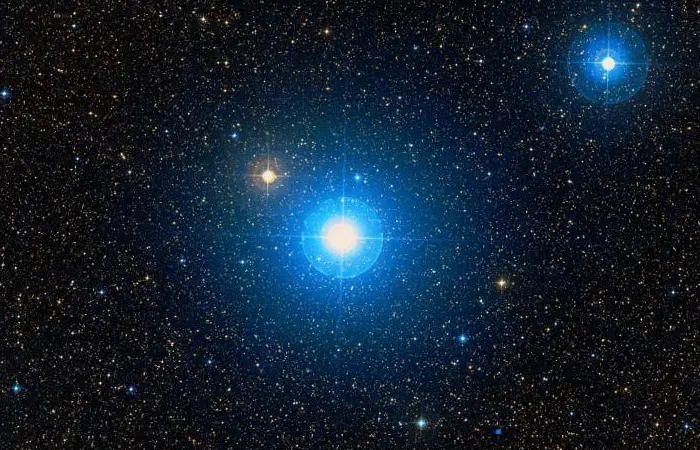
Muhlifain (Gamma Centauri), image: Wikisky (DSS)
Facts
Shining at magnitude 2.17, Gamma Centauri is on average the 64th brightest star in the sky. It is about as bright as Denebola in the constellation Leo, Naos in Puppis, and Gamma Cassiopeiae in Cassiopeia.
Gamma Centauri appears close to Tau Centauri and w Centauri in the sky. The fainter w Centauri (HD 110458) is not related to its brighter neighbours. It is an evolved K-type giant located approximately 191 light-years away.
However, Tau Centauri is likely a co-moving companion of the brighter Gamma. It is an A-type main sequence star or subgiant located 131 light-years away. It shines at magnitude 3.86 and has an estimated age of 132 million years. The estimated separation between Gamma and Tau Centauri is only 1.72 light-years (0.53 parsecs). In comparison, the distance between the Sun and its nearest neighbour Proxima Centauri is 4.2465 light-years.
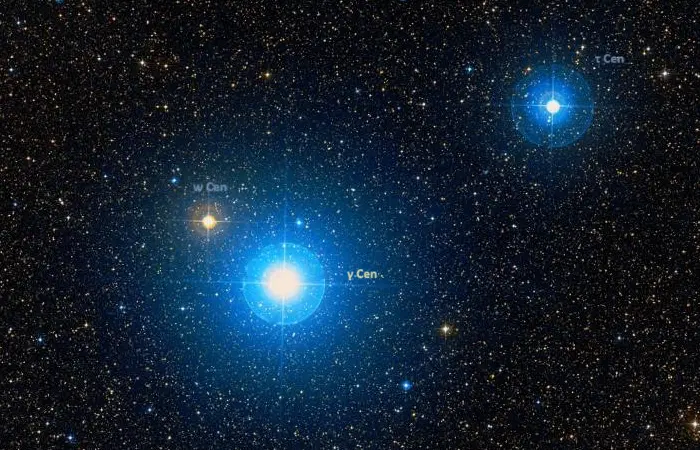
Gamma Centauri, Tau Centauri and w Centauri, image: Wikisky (DSS)
The Arrernte and Luritja peoples near Hermannsburg in Central Australia call the asterism formed by Gamma Centauri, Delta Centauri, Imai (Delta Crucis) and Gacrux (Gamma Crucis) the Eagle-hawk (Iritjinga).
Name
Gamma Centauri does not have a proper name formally approved by the International Astronomical Union (IAU). It has traditionally been known as Muhlifain (pronunciation: /ˈmjuːlɪfeɪn/).
The name Muhlifain has the same root as Muliphein, the formal name of Gamma Canis Majoris. The names are derived from the Arabic ʼal-Muḥlifayn and mean “two things,” “a pair” or “swearing of an oath.” The traditional name of Gamma Centauri may have been taken from Gamma Canis Majoris.
In Chinese astronomy, Gamma Centauri was known as 庫樓七 (Kù Lóu qī), the Seventh Star of Arsenal. Arsenal is an asterism formed by Gamma Centauri with Zeta Centauri, Eta Centauri, Menkent (Theta Centauri), 2 Centauri, d Centauri, f Centauri, Tau Centauri, D Centauri, and Sigma Centauri. The asterism is part of the larger Horn mansion, which represents the horns of the Azure Dragon.
Location
Gamma Centauri lies near the Southern Cross, one of the most familiar asterisms in the southern night sky. It is the brightest star located along the imaginary line extended through the long axis of the asterism, from Acrux through Gacrux.
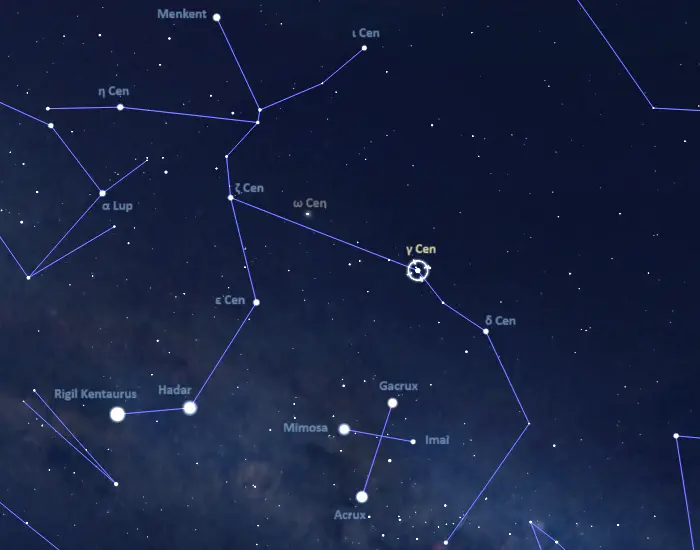
The location of Muhlifain (Gamma Centauri), image: Stellarium
Gamma Centauri can be used to find several bright deep sky objects. The globular cluster Omega Centauri and the galaxies NGC 4945 (Caldwell 83, the Tweezers Galaxy) and NGC 4976 appear in the region between Gamma and the fainter Zeta Centauri.
Omega Centauri, the largest and most massive globular cluster in the Milky Way, has an apparent magnitude of 3.9 and is visible to the unaided eye. The barred spiral galaxy NGC 4945 has an apparent magnitude of 9.3 and can be observed in amateur telescopes. The galaxy is one of the brightest members of the Centaurus A/M83 Group. The fainter peculiar elliptical galaxy NGC 4976 has a visual magnitude of 11 and is a more challenging target.
Centaurus A (NGC 5128, Caldwell 77), the fifth brightest galaxy in the sky, lies roughly halfway between Gamma Centauri and the brighter Menkent at the Centaur’s shoulder. With an apparent magnitude of 6.84, the galaxy can be seen in a small telescope.
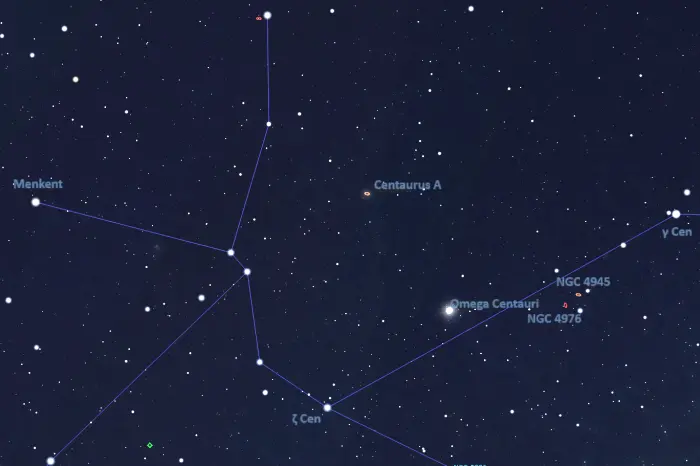
Gamma Centauri, Centaurus A, Omega Centauri, NGC 4945 and NGC 4976, image: Stellarium
Constellation
Gamma Centauri is located in the constellation Centaurus (the Centaur). Centaurus is one of the 48 Greek constellations catalogued by Claudius Ptolemy of Alexandria in his Almagest in the 2nd century CE. It is the ninth largest constellation in the sky and one of the brightest. It stretches across 1,060 square degrees of the southern sky.
Centaurus hosts Alpha and Beta Centauri (Rigil Kentaurus and Hadar), the third and 11th brightest stars in the sky. The Alpha Centauri system contains Proxima Centauri, the nearest star to the Sun.
Other notable stars in Centaurus include the orange giant Menkent (Theta Centauri), the hot blue Beta Cephei variable Epsilon Centauri, the Gamma Cassiopeiae variables Eta Centauri and Delta Centauri, the hypergiant V766 Centauri (one of the largest stars known), the Mira variable R Centauri, the chemically peculiar Delta Scuti variable known as Przybylski’s Star, the variable red giant 2 Centauri, the semiregular variable V810 Centauri, and the so-called Diamond Star or Lucy (BPM 37093), a variable white dwarf with a crystalline mass of more than 5 x 1029 kg.
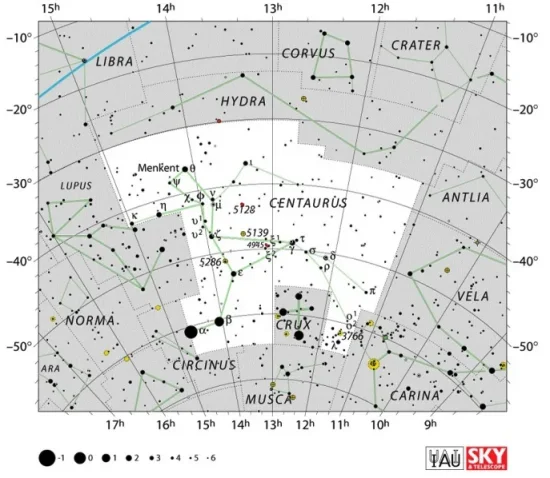
Centaurus constellation map by IAU and Sky&Telescope magazine
Centaurus hosts many bright deep sky objects. These include the globular cluster Omega Centauri, visible to the unaided eye, the bright open clusters NGC 3766 and NGC 5460, the Running Chicken Nebula (IC 2944), the Blue Planetary Nebula (NGC 3918), the protoplanetary Boomerang Nebula (LEDA 3074547), the spiral galaxy NGC 4622, the irregular galaxy NGC 5253, and Centaurus A (NGC 5128), one of the nearest active galaxies to the Sun.
The best time of the year to observe the stars and deep sky objects in Centaurus is during the month of May, when the constellation appears higher above the horizon in the early evening. The entire constellation is visible from locations south of the latitude 25° N.
The 10 brightest stars in Centaurus are Alpha Centauri (mag. -0.27), Hadar (Beta Cen, mag. 0.61), Menkent (Theta Cen, mag. 2.06), Gamma Centauri (mag. 2.17), Epsilon Centauri (mag. 2.30), Eta Centauri (mag. 2.35), Leepwal (Zeta Cen, mag. 2.55), Delta Centauri (mag. 2.57), Kulou (Iota Cen, mag. 2.73), and Lambda Centauri (mag. 3.13).
Gamma Centauri
| Spectral class | A1IV (A1IV + A0IV) |
| U-B colour index | -0.01 |
| B-V colour index | -0.01 |
| Apparent magnitude | 2.17 (2.85/2.95) |
| Absolute magnitude | -0.81 |
| Distance | 130 ± 1 light-years (39.9 ± 0.4 parsecs) |
| Parallax | 25.06 ± 0.28 mas |
| Radial velocity | -5.5 ± 1.78 km/s |
| Proper motion | RA: −185.72 ± 0.20 mas/yr |
| Dec.: +5.79 ± 0.16 mas/yr | |
| Mass | 2.91 M☉ |
| Temperature | 9,082 K |
| Metallicity | -0.29 |
| Surface gravity | 3.52 cgs |
| Constellation | Centaurus |
| Right ascension | 12h 41m 31.04008s |
| Declination | −48° 57′ 35.5375″ |
| Names and designations | Muhlifain, Gamma Centauri, γ Cen, HD 110304, HR 4819, HIP 61932, SAO 223603, CD−48°7597, CPD-48 4965, PLX 2922, PPM 317697, GC 17262, GCRV 7619, LTT 4841, JP11 2264, ALS 19677, GSC 08240-02724, TIC 161739042, UBV 11369, IRAS 12387-4841, 2MASS J12413103-4857350, Gaia DR3 6127791439360208640, CCDM J12415-4858, IDS 12360-4825 AB, WDS 12415-4858 |